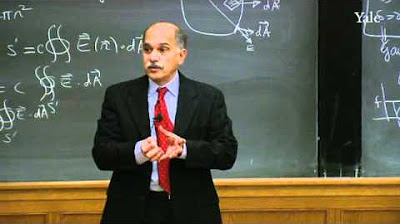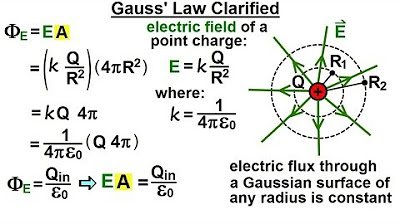What is Electric Charge? (Electrodynamics)
TLDRThe video script delves into the concept of electric charge, a fundamental property of objects and particles that interacts with the electromagnetic field. It explains that charge, available in two types (positive and negative), is responsible for the attraction and repulsion between objects, akin to mass and gravity. The script also touches on the historical labeling of charges by Ben Franklin and emphasizes the conservation of charge over time. By using the analogy of the gravitational field, the script introduces Gauss's law as a means to understand the relationship between charge and the electric field, highlighting charge's role in coupling objects to space.
Takeaways
- 🔋 Objects can possess electric charge as a property, similar to mass or temperature.
- 🎈 Charges are generated through the transfer of electrons, as seen with balloons, hair, or plastic.
- 🔬 Inside atoms, protons and neutrons are central and heavier, while electrons are lighter and外围.
- 💫 When objects with charges interact, they either attract (opposite charges) or repel (like charges).
- 🏔️ The concept of charge is closely linked to the electromagnetic field, which is a field value assigned to every point in space.
- 🌐 Mass and fields (like the gravitational field) can be thought of as properties of objects and space, respectively.
- 📐 Gauss's law is a fundamental principle connecting the electric field to charge, similar to how it connects the gravitational field to mass.
- 🔍 By using Gauss's law, one can determine the presence and quantity of charge by observing the electric field.
- ⚡ The electromagnetic field is typically considered as two separate vector fields: one for electricity and one for magnetism.
- 🌀 When a charge is stationary, the magnetic component of the electromagnetic field is negligible, highlighting only the electric field.
- 📉 Electric charge is conserved over time and is a fundamental property that objects and particles have in relation to the electromagnetic field and space.
Q & A
What is electric charge?
-Electric charge is a fundamental property of objects or particles that connects them to the electromagnetic field and, therefore, to space. It comes in two types, positive and negative, which display opposite behaviors and are conserved across time.
How do objects become charged?
-Objects become charged by transferring electrons, such as when rubbing a balloon against someone's hair. This process can result in the object gaining or losing electrons, leading to a net positive or negative charge.
What happens when objects with opposite charges interact?
-Objects with opposite charges attract each other, similar to how masses attract in Newtonian gravity. This interaction is due to the electromagnetic force, which is a fundamental force in nature.
What is the significance of the terms 'positive' and 'negative' in the context of electric charge?
-The terms 'positive' and 'negative' are labels used to differentiate the two types of electric charge. They were established by Benjamin Franklin and are used for mathematical convenience, indicating opposite behaviors in their interactions.
How does the concept of charge relate to the behavior of electrons and protons in an atom?
-Protons in an atom have a positive charge, while electrons have a negative charge. The electromagnetic force causes these charged particles to be attracted to each other, maintaining the structure of the atom.
What is the electromagnetic field and how is it related to electric charge?
-The electromagnetic field is a field that exists around charged particles and is a combination of electric and magnetic fields. Electric charge and the electromagnetic field are inseparable; understanding one requires understanding the other.
What is Gauss's law and how does it apply to electric fields?
-Gauss's law is a fundamental law of physics that relates the electric field to the charge enclosed within a closed surface. It states that the total flux through the surface is proportional to the total charge enclosed, providing a way to calculate the distribution of charge.
How does the behavior of the electromagnetic field change when a charge is stationary versus when it is moving?
-When a charge is stationary, only the electric part of the electromagnetic field is significant, with the magnetic part dropping to zero. However, when a charge is moving, both electric and magnetic fields are involved, creating a dynamic electromagnetic field around the moving charge.
What is the role of the electromagnetic field in the conservation of charge?
-The electromagnetic field plays a crucial role in the conservation of charge, as it is through this field that the interactions between charged particles occur. The conservation of charge is a fundamental principle stating that charge cannot be created or destroyed, only transferred between particles.
Why is understanding electric charge important?
-Understanding electric charge is important because it is a fundamental property that governs the electromagnetic interactions in the universe. It is key to explaining a wide range of phenomena, from the behavior of atoms to the functioning of electronic devices and power generation.
How did the concept of electric charge evolve historically?
-The concept of electric charge has evolved over centuries, with significant contributions from scientists like Benjamin Franklin, who labeled the two types of charge as positive and negative. The modern understanding of charge and its relation to the electromagnetic field was further developed with the advent of electromagnetism theory.
Outlines
🔋 Understanding Electric Charge
This paragraph introduces the concept of electric charge, a fundamental property of objects similar to mass or temperature. It explains that objects become charged by transferring electrons, like when a balloon rubs against hair, resulting in an attractive force between the two objects. The concept of positive and negative charges is introduced, highlighting that these are labels for mathematical convenience and that opposite charges attract while like charges repel. The historical context of charge labeling by Ben Franklin is mentioned. The paragraph also touches on the connection between charge and the electromagnetic field, emphasizing the need to understand both to fully grasp the concept of charge.
🌐 Electric Charge and the Electromagnetic Field
This paragraph delves deeper into the relationship between electric charge and the electromagnetic field. It explains that electric charge is a property that links objects or particles to the electromagnetic field and space. The concept of vector fields is introduced as a simpler alternative to tensor fields for understanding the changes in the electric and magnetic vectors as a charge moves through space. The paragraph focuses on the electric part of the electromagnetic field and introduces Gauss's law as a way to understand the connection between the electric field and charge. It also mentions the conservation of charge over time and the significance of this property in the understanding of physical phenomena.
Mindmap
Keywords
💡electric charge
💡quantum mechanics
💡protons
💡electrons
💡electromagnetic field (EM field)
💡Gauss's law
💡mass
💡positive and negative charges
💡field
💡conservation of charge
💡vector
Highlights
Electric charge is a fundamental property of objects, similar to mass or temperature.
Objects become charged by transferring electrons, such as when rubbing a balloon against hair.
Inside atoms, protons and neutrons are the heavier particles, while electrons are lighter and can be gained or lost.
Charged objects can attract or repel each other without touching, similar to Newtonian gravity.
Charge comes in two types, positive and negative, named for mathematical convenience.
Ben Franklin labeled charges in 1748, and we've been using his labels ever since.
Opposite charges attract and like charges repel, a principle that shapes the structure of atoms.
An electron gain results in a negative charge, while an electron loss results in a positive charge.
Understanding charge requires understanding its connection to the electromagnetic field.
A field assigns a value or set of values to every point in space, like the gravitational field around the Earth.
Gauss's law relates the electric field to charge and can be visualized with a sphere enclosing mass.
Electric charge is conserved across time, and its quantity is universally agreed upon.
Charge is a coupling property that connects objects and particles to the electromagnetic field and space.
The electromagnetic field is more complex than a simple vector field, involving both electric and magnetic components.
Gauss did not use vector fields but quaternions, a concept that can be further explored through other resources.
The video invites viewers to engage with the content, ask questions, and continue learning about the topics discussed.
Transcripts
5.0 / 5 (0 votes)
Thanks for rating:





